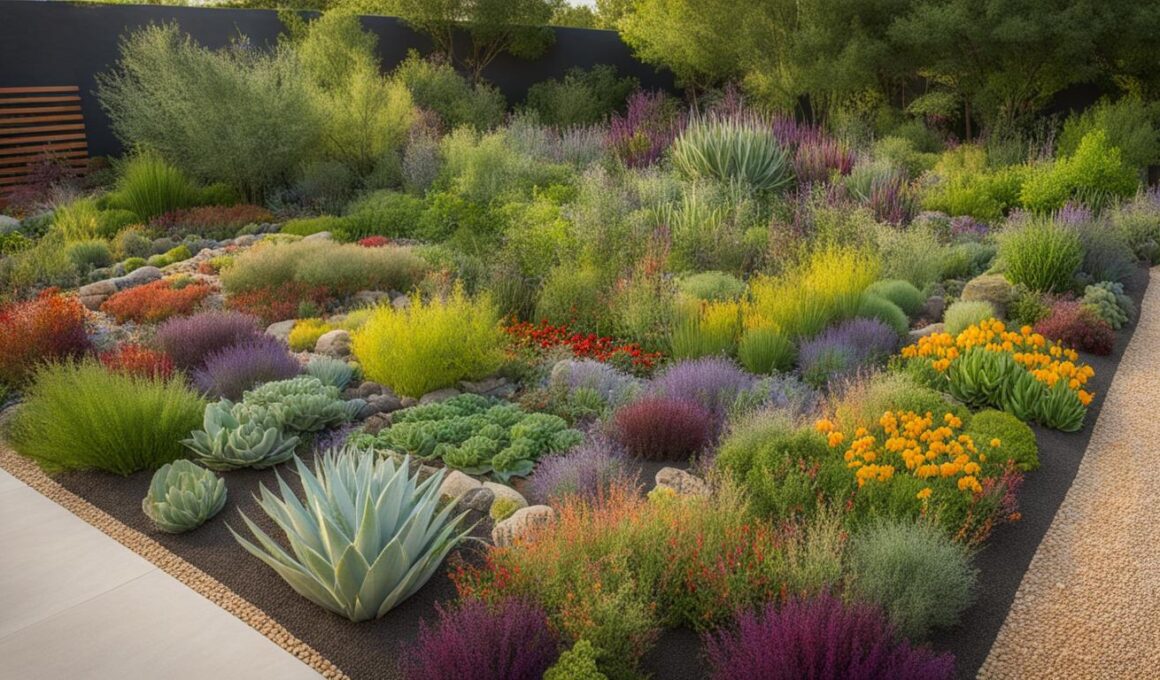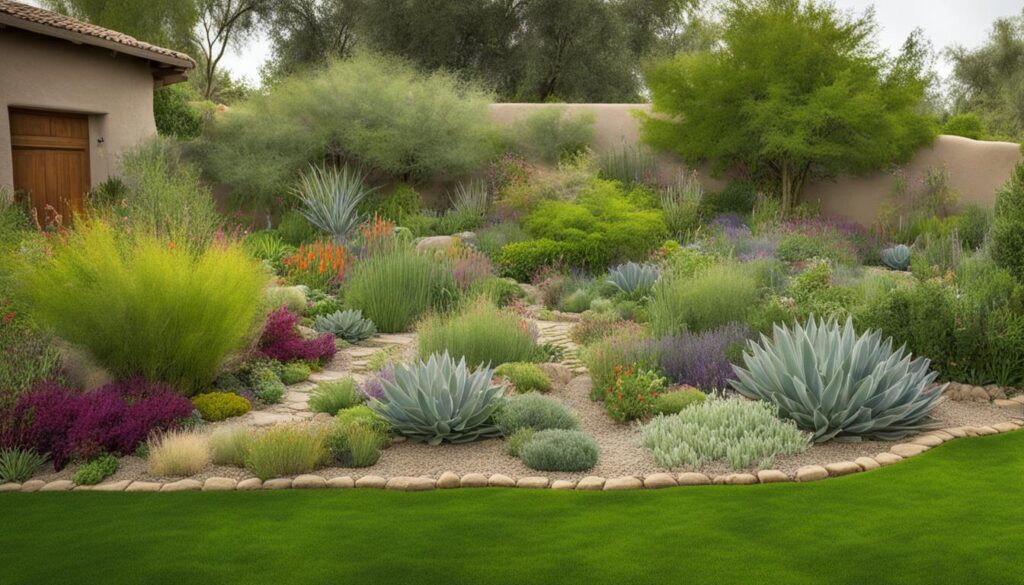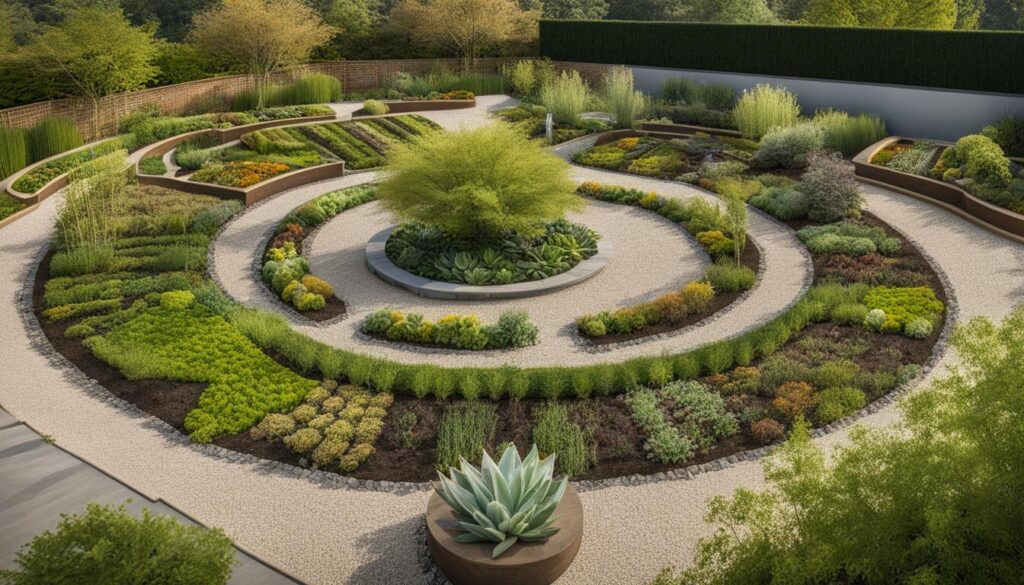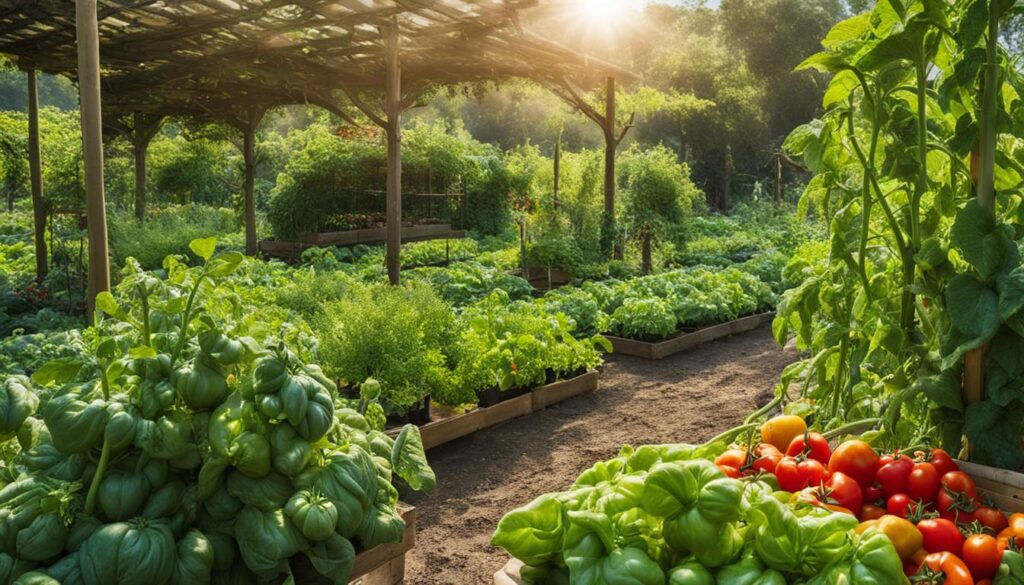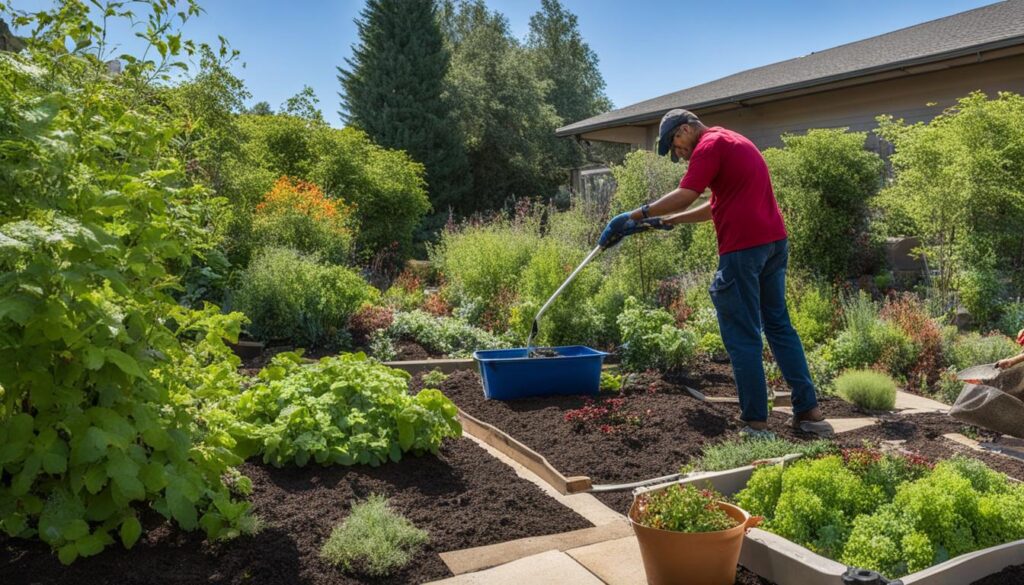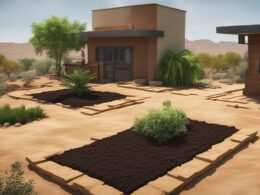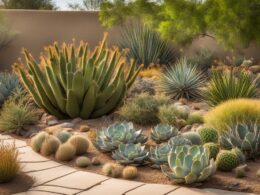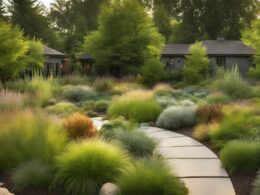Xeriscape gardening is a sustainable approach to landscaping that conserves water while still allowing for the growth of beautiful and functional plants. One way to enhance the sustainability of your xeriscape garden is by incorporating edible plants into your landscape. By growing your own food, you can reduce your reliance on store-bought produce and enjoy the fresh taste of homegrown fruits, vegetables, and herbs. In this article, we will explore a variety of edible plants that are well-suited for xeriscape gardening and provide tips on how to incorporate them into your landscape.
Key Takeaways:
- Integrating edible plants into your xeriscape garden promotes self-sufficiency and reduces reliance on store-bought produce.
- Edible plants enhance the visual appeal of your landscape while providing practical benefits.
- Xeriscape gardening with edible plants reduces the need for excessive watering, making it more sustainable.
- Choosing well-adapted edible plants and designing your garden strategically can create a beautiful and functional space.
- Maximizing space and productivity in your edible xeriscape garden can be achieved through techniques like vertical gardening and interplanting.
Benefits of Edible Plants in Xeriscape Gardens
Growing edible plants in your xeriscape garden offers a multitude of benefits. Firstly, it allows you to take control of your food production, promoting self-sufficiency and reducing your ecological footprint. By cultivating your own fruits, vegetables, and herbs, you can enjoy the satisfaction of eating fresh, organic produce right from your backyard.
Additionally, incorporating edible plants into your xeriscape garden adds beauty and visual interest to your landscape. The vibrant colors, unique textures, and lovely blooms of edible plants can enhance the overall aesthetic appeal of your garden. Not only do they provide a practical purpose, but they also contribute to the visual harmony and diversity of your outdoor space.
Moreover, growing edible plants in a xeriscape garden aligns with sustainable practices by reducing the need for excessive watering. These plants are often well-adapted to arid conditions and require minimal water once established. By choosing drought-tolerant edible plants, you can conserve water resources and create a more environmentally-friendly garden that thrives even in dry climates.
Quoted Expert Advice:
“Incorporating edible plants into your xeriscape garden not only provides you with fresh, homegrown food, but also promotes a sustainable and environmentally-friendly lifestyle. It’s a win-win situation for both you and the planet.” – [Expert Name], Sustainable Gardening Specialist
With the numerous benefits they offer, edible plants are a valuable addition to any xeriscape garden. They provide you with a source of nourishment, enhance the visual appeal of your landscape, and contribute to the conservation of water resources. By embracing the concept of sustainable gardening and incorporating edible plants into your xeriscape garden, you can create a thriving oasis that is both beautiful and environmentally-conscious.
Best Edible Plants for Xeriscape Gardening
When it comes to selecting edible plants for your xeriscape garden, choosing species that are well-adapted to arid conditions and require minimal water is key. Here are some of the best edible plants that thrive in xeriscape gardens:
- 1. Herbs: Herbs like rosemary, lavender, and thyme not only add fragrance and beauty to your garden, but they also provide an abundance of culinary uses. These plants are drought-tolerant and require little water once established.
- 2. Fruit Trees: Dwarf fruit trees such as pomegranates, figs, and citrus varieties can be excellent additions to your xeriscape garden. These trees produce delicious fruits while requiring less water compared to their larger counterparts.
- 3. Leafy Greens: Leafy greens like kale, Swiss chard, and spinach are ideal for xeriscape gardens. They are packed with nutrients and can be harvested throughout the year, providing a constant supply of fresh greens for your meals.
- 4. Root Vegetables: Root vegetables such as carrots, beets, and radishes are well-suited for xeriscape gardening. These hardy plants can tolerate dry conditions and produce nutrient-rich, flavorful harvests.
- 5. Perennial Vegetables: Perennial vegetables like asparagus, artichokes, and rhubarb can be a great addition to your xeriscape garden. Once established, these plants require minimal care and provide a continuous harvest for years to come.
By choosing these best edible plants for your xeriscape garden, you can enjoy a variety of fresh and flavorful produce while conserving water and promoting sustainability.
Creating a Diverse and Resilient Garden
In order to create a diverse and resilient xeriscape garden, it’s important to choose a combination of edible plants that complement each other. By incorporating a mix of fruits, vegetables, and herbs, you can create a balanced ecosystem that supports pollinators and beneficial insects.
Additionally, consider planting a variety of plants with different growth habits and harvest times. This will ensure a continuous supply of fresh produce throughout the growing season. Mixing crops with varying water requirements can also help optimize water usage in your garden.
Remember to provide adequate spacing between plants to allow for proper airflow and sunlight penetration. This will help prevent the spread of diseases and ensure healthy growth. Creating a diverse and resilient xeriscape garden not only enhances the productivity of your edible plants but also contributes to the overall beauty and sustainability of your landscape.
Designing Your Edible Xeriscape Garden
Designing an edible xeriscape garden requires careful planning to ensure a harmonious integration of edible plants into your landscape. Consider the height, size, and mature form of each plant when determining placement. Distribute tall elements evenly throughout the garden to maintain balance. Pay attention to the colors, textures, and seasonal variety of the plants to create an aesthetically pleasing and cohesive design.
“A well-designed edible xeriscape garden not only provides food but also elevates the visual appeal of your landscape.” – Gardening Expert
Creating Zones
Scatter different clumps of plants throughout the landscape to create defined zones. This helps organize your garden and makes it easier to manage. Designate areas for fruit trees, herbs, vegetables, and flowers. By separating the plants into distinct zones, you can improve accessibility and maximize the use of space.
Groundcovers and Herbs
Incorporate groundcovers and herbs to add visual interest and fill in gaps between plantings. Groundcovers such as thyme and creeping thyme not only suppress weeds but also release aromatic scents when stepped on. Herbs like rosemary and lavender not only provide culinary uses but also attract beneficial insects and add fragrance to your garden.
Vertical Gardening
Take advantage of vertical gardening techniques to make the most of limited space. Install trellises, arbors, or vertical planters to grow vining plants like tomatoes, cucumbers, and beans. This not only saves space but also creates a visually striking feature in your edible xeriscape garden.
With strategic planning and a thoughtful design, you can create a beautiful and functional edible xeriscape garden that not only provides a bountiful harvest but also enhances the overall aesthetics of your landscape.
Maximizing Space and Productivity in Your Edible Xeriscape Garden
When designing your edible xeriscape garden, it’s essential to make the most of the available space to increase productivity and create a vibrant and thriving garden. Here are some innovative techniques you can use to maximize space and enhance the productivity of your edible xeriscape garden:
1. Vertical Gardening:
Vertical gardening is an excellent technique for utilizing vertical space and growing more plants in a limited area. Install trellises, stakes, or wall-mounted containers to support climbing plants like beans, cucumbers, and peas. This technique not only saves space but also adds visual interest to your garden.
2. Intercropping and Succession Planting:
Interplanting different crops with varying heights and growth habits in the same bed can maximize space and productivity. For example, you can grow fast-maturing lettuce or radishes between slower-growing plants like tomatoes or peppers. This way, you can harvest multiple crops from the same space throughout the growing season.
3. Raised Beds and Containers:
Raised beds and containers are ideal for small spaces or areas with poor soil quality. They provide better control over soil conditions and allow you to grow a wide range of plants in a compact area. Use tiered containers or stacked raised beds to further maximize space.
“Vertical gardening and intercropping are great techniques to make the most of your space and increase the productivity of your edible xeriscape garden.”
Remember to choose plants that are suitable for your climate and garden conditions. Pay attention to their growth habits, spacing requirements, and companion planting guidelines to ensure optimal results. By using these space-saving techniques, you can create a productive and visually appealing edible xeriscape garden, even in small or limited spaces.
With careful planning and creative thinking, you can create an abundant and efficient edible garden that not only saves space but also provides a bountiful harvest. So, get ready to enjoy the fruits of your labor and savor the flavors of your very own edible xeriscape garden.
Utilizing Common Landscape Plants for Food Production
Incorporating edible plants into your xeriscape garden is a sustainable and rewarding way to enjoy fresh and nutritious food while conserving water. But did you know that you can also utilize common landscape plants for food production? By tapping into the edible components of these plants, you can further enhance the practicality and sustainability of your garden.
Hostas, for example, are commonly grown for their ornamental foliage, but their flowers and early shoots are also edible. They add a unique flavor and texture to salads and stir-fries. Roses, another popular landscaping plant, not only provide beautiful flowers but also produce edible flowers and hips, which are rich in vitamin C. Incorporating roses into your edible xeriscape garden allows you to enjoy their beauty while adding a practical and nutritious element.
Redbud trees offer more than just beautiful blooms. Their flower buds are edible and can be used as a garnish or added to salads. Daylilies, with their vibrant petals, are not only visually appealing but also offer edible petals, buds, shoots, and tubers. They provide a variety of flavors and can be used in both sweet and savory dishes.
By exploring the edible potential of common landscape plants, you can make the most of your existing garden while adding a new dimension to your edible xeriscape garden. It’s an innovative way to maximize your space and increase the productivity of your garden, all while enjoying the beauty and convenience of a sustainable landscape.
Key Takeaways:
- Common landscape plants can serve dual purposes by providing both visual appeal and edible components.
- Hostas offer edible flowers and early shoots, adding a unique flavor to culinary creations.
- Roses produce edible flowers and hips that are rich in vitamin C.
- Redbud trees have edible flower buds, and daylilies offer edible petals, buds, shoots, and tubers.
- Incorporating these plants into your edible xeriscape garden enhances its practicality and sustainability.
What are the Best Edible Plants to Grow in a Xeriscape Garden for Sustainable Gardening?
When planning a xeriscape garden for sustainable gardening, consider growing edible plants for xeriscaping. Some of the best options include lavender, rosemary, thyme, and sage, which are all drought-tolerant and require minimal water. These plants not only add beauty to the garden but also provide fresh herbs for cooking.
Maintaining Your Edible Xeriscape Garden
Once you have established your edible xeriscape garden, proper maintenance is key to ensuring its success and longevity. By following these essential maintenance practices, you can keep your garden thriving and productive:
- Regular watering: During the establishment phase, it is crucial to provide regular watering to help plants establish their root systems. As your garden matures, adjust watering based on the specific needs of each plant. Consider using drip irrigation or a soaker hose to efficiently deliver water to the root zone while minimizing evaporation.
- Mulching: Apply a layer of organic mulch, such as wood chips or straw, around your plants to help retain moisture, regulate soil temperature, and suppress weeds. Mulching also adds organic matter to the soil as it breaks down over time.
- Weeding: Stay on top of weeds by regularly inspecting your garden and removing them promptly. Weeds compete with your edible plants for water and nutrients, so minimizing their presence will help your plants thrive.
- Pruning and harvesting: Prune your plants as needed to remove dead or damaged branches and promote healthy growth. Harvest your edible crops when they are ripe to encourage continuous productivity and prevent over-ripening.
- Organic principles and natural pest control: Emphasize organic practices such as composting and using natural pest control methods. Avoid chemical pesticides and fertilizers, as they can harm beneficial insects and disrupt the ecological balance of your garden.
By implementing these maintenance practices, you can ensure the health and productivity of your edible xeriscape garden, resulting in a sustainable and bountiful source of fresh food for years to come.
Maintaining Your Edible Xeriscape Garden: Expert Tips
Here are a few additional expert tips to help you maintain your edible xeriscape garden:
- Monitor soil moisture: Regularly check the moisture level of your soil to ensure it remains within the optimal range for your plants. Avoid overwatering, as it can lead to root rot and other moisture-related issues.
- Implement crop rotation: Rotate your edible crops each season to prevent the buildup of pests and diseases in the soil. This practice helps maintain the overall health of your garden and reduces the need for chemical interventions.
- Encourage pollinators: Attract beneficial pollinators, such as bees and butterflies, to your garden by planting native flowering plants and providing water sources. Pollinators play a vital role in the reproduction of many edible plants.
- Stay vigilant for pests: Regularly inspect your plants for signs of pests and take appropriate action if necessary. Use natural pest control methods, such as handpicking insects or introducing beneficial insects like ladybugs.
By incorporating these expert tips into your maintenance routine, you can further enhance the health and sustainability of your edible xeriscape garden, ensuring a thriving and fruitful garden ecosystem.
Conclusion
Incorporating edible plants into your xeriscape garden is a sustainable and rewarding way to enjoy fresh and nutritious food while conserving water and promoting a more environmentally friendly lifestyle. By carefully selecting and designing your garden, maximizing space and productivity, utilizing common landscape plants, and maintaining proper care, you can create a thriving and beautiful edible xeriscape garden that is both sustainable and visually appealing.
Start growing your own food and transform your landscape into a bountiful and sustainable oasis. By growing edible plants in your xeriscape garden, you not only reduce your reliance on store-bought produce but also get to savor the flavors of homegrown fruits, vegetables, and herbs.
Whether you have a small balcony or a spacious backyard, there are various options available to suit your needs. From herbs and salad greens to fruit trees and flowering perennials, the choices are plentiful. By incorporating edible plants into your xeriscape garden, you are not only creating a beautiful space but also contributing to a more sustainable and environmentally friendly future.





